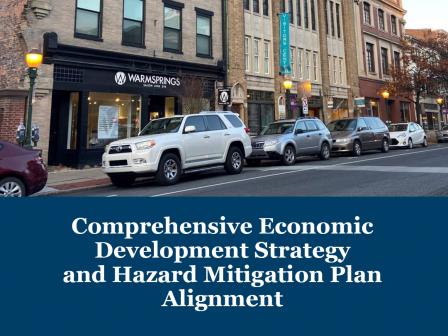
FEMA and EDA Release New Resource to Align Community Plans and Build Resilience
A new resource will help economic development and hazard mitigation planners achieve mutually beneficial outcomes.
The Comprehensive Economic Development Strategy and Hazard Mitigation Plan Alignment Guide connects economic development and hazard mitigation plans so communities can be more resilient from natural hazards. The guide was a collaboration between FEMA and the U.S. Economic Development Administration (EDA).
Communities, states and federal officials can use the guide when preparing or reviewing FEMA Hazard Mitigation Plans and EDA Comprehensive Economic Development Strategies (CEDS). Included in the guide are strategies to help align strategies with approved local plans.
When communities align their CEDS and mitigation plans:
- Businesses and business districts are built in safer areas with a lower risk of hazard impacts.
- Private investment is directed to safer areas. It is also developed to be more resilient to hazards.
- Buildings are placed and built to design standards that help withstand hazard events.
- Businesses can reopen more quickly after hazard events.
- Critical facilities and infrastructure keep working during and after events.
- Economies can diversify. This builds the ability to withstand and recover from hazard events.
- Local and regional partners can identify and plan for shared goals to protect, sustain and diversify the inter-connected economic base.
- Regional marketability improves as businesses and investors see the community as safe and well prepared.
- The community can manage open space and natural resources in ways that reduce hazard impacts and support the economy through agriculture and tourism.
Hazard mitigation plans and CEDS are key plans to improve resilience. A CEDS must include economic resilience in its strategy while a hazard mitigation plan identifies and plans for natural hazard risks to key sectors, including the economy.
Aligning hazard mitigation plans with CEDS will create more resilient communities and businesses. It incentivizes investments that support safer and more resilient housing, businesses and workforce.
Community partners will coordinate better, share priorities and actions that reduce risk, and better use a wide range of resources and funding when hazard mitigation and economic plans are aligned. This is because plans reinforce each other and are easier to implement.
The guide includes economic development concepts to add to hazard mitigation plans. It also encourages integration of information from risk assessments and hazard mitigation ideas to use in a CEDS.
To view and download the guide, visit the disaster recovery section of eda.gov.
